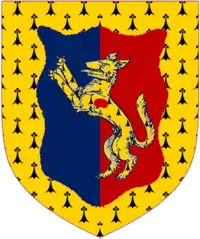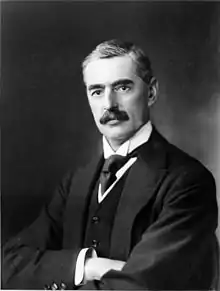Maurice Hankey, 1st Baron Hankey
Maurice Pascal Alers Hankey, 1st Baron Hankey, GCB, GCMG, GCVO, PC, FRS[1] (1 April 1877 – 26 January 1963) was a British civil servant who gained prominence as the first Cabinet Secretary and later made the rare transition from the civil service to ministerial office. He is best known as the highly-efficient top aide to Prime Minister David Lloyd George and the War Cabinet, which directed Britain during the First World War.
The Lord Hankey | |
|---|---|
 | |
| Cabinet Secretary | |
| In office 1916 – August 1938 | |
| Prime Minister | |
| Preceded by | Inaugural holder |
| Succeeded by | Sir Edward Bridges |
| Chancellor of the Duchy of Lancaster | |
| In office 14 May 1940 – 20 July 1941 | |
| Prime Minister | Winston Churchill |
| Preceded by | The Lord Tryon |
| Succeeded by | Duff Cooper |
| Personal details | |
| Born | 1 April 1877 |
| Died | 26 January 1963 (aged 85)[1] |
| Wikisource has original works written by or about: Maurice Hankey, 1st Baron Hankey |
In the estimation of his biographer John F. Naylor, Hankey held to the "certainties of a late Victorian imperialist, whose policies sought to maintain British domination abroad and to avoid as far as possible British entanglement within Europe. His patriotism stands inviolable, but his sensitivity to processes of historical change proved limited". Naylor found, "Hankey did not altogether grasp the virulence of fascism... except as a military threat to Britain; nor did he ever quite comprehend the changing face of domestic politics which Labour's emergence as a party of government entailed.... In these shortcomings Hankey was typical of his generation and background; that his responsibility was greater lay in the fact that he was better informed than nearly any of his contemporaries".[2][3]
Early life
The third son of R. A. Hankey, Maurice Hankey was born at Biarritz in 1877 and educated at Rugby School. He joined the Royal Marine Artillery, was promoted captain and served in successive roles, including as coastal defence analyst in the War Division of the Naval Intelligence Department (1902–1906).[4]
In 1908, he was appointed Naval Assistant Secretary to the Committee of Imperial Defence and became Secretary to the Committee in 1912, a position that he would hold for the 26 years.
In November 1914, he took on the additional duty of Secretary of the War Council. In that function, he took notice of the ideas of Major Ernest Swinton to build a tracked armoured vehicle and brought them to the attention of Winston Churchill on 25 December 1914. That led to the eventual creation of the Landships Committee.
Lloyd George's War Cabinet
In December 1916, David Lloyd George became Prime Minister and greatly changed how the government was run. A small War Cabinet was instigated, and Hankey was appointed as its Secretary and served as Secretary of the Imperial War Cabinet, which also incorporated representatives of the Colonies and Dominion governments. He gained such a reputation for strong competency that when the full Cabinet was restored in 1919, the secretariat was retained, and Hankey then served as Secretary to the Cabinet for 19 years.
Clerk of the Privy Council
In 1923, he acquired the further position of Clerk of the Privy Council. During his long tenure, he would also often serve as British Secretary to many international conferences and Secretary-General of many Imperial Conferences.
Retirement from government
In August 1938, Hankey retired from government and became a British Government Director of the Suez Canal Company, a post that he would hold for only one year.
In the 1939 New Year Honours, he was ennobled as Baron Hankey, of The Chart in the County of Surrey.[5][6] Hankey remained a respected figure and was often consulted by ministers and civil servants for advice.
Chamberlain's War Cabinet
In August 1939, he advised Neville Chamberlain about the formation of a new War Cabinet and, the following month, became another of Chamberlain's many non-party political appointments when he was made Minister without Portfolio and a member of the War Cabinet. Hankey was personally reluctant to take on the task but agreed to do so. He became Chancellor of the Duchy of Lancaster when Chamberlain was succeeded by Winston Churchill in May 1940 but was left out of Churchill's War Cabinet.
In July 1941, Lord Hankey was moved to the position of Paymaster-General, but the following year, he was dropped from the Government altogether. He continued to hold other positions in both the public and private sector until his death.
Writings
After World War II, Hankey emerged as a leading critic of the war crimes trials, and in his 1950 book Politics, Trials and Errors, he argued that the Allies had no right to convict German and Japanese leaders of war crimes. Hankey kept a series of at times startlingly-detailed handwritten diaries throughout most of his years in government, including during his time as Secretary to the War Council and Imperial War Cabinet of the First World War. The diaries are currently held at the Churchill Archives Centre in Cambridge, England, and can be read by the public.
Family
His youngest brother, Donald Hankey, was a soldier best known for a series of essays that he wrote while he served on the western front in World War I. Donald died in action at the Somme.
Lord Hankey died in 1963, aged 85, and was succeeded in his barony by his eldest son, Robert.
Honours
In the 1912 Birthday Honours, Hankey was appointed to the Order of the Bath as a Companion.[7] He was then promoted within the same order as a Knight Commander in 1916[8] and as a Knight Grand Cross in 1919.[9] In the 1929 Birthday Honours, Sir Maurice was appointed to the Order of St Michael and St George as a Knight Grand Cross.[10] In the 1934 New Year Honours, Sir Maurice was appointed to the Royal Victorian Order as a Knight Grand Cross.[11]
In the 1939 New Year Honours, he was raised to the peerage as Baron Hankey, of The Chart in the County of Surrey.[5][6] The same l year, he was also appointed to the Privy Council.[12] In 1942, he was elected to the Royal Society as a Fellow under Statute 12 for those "who have rendered conspicuous service to the cause of science, or are such that election would be of signal benefit to the Society".[13]
  |
|
References
- Schonland, B. F. J. (1964). "Maurice Pascal Alers Hankey, First Baron Hankey of the Chart 1877–1963". Biographical Memoirs of Fellows of the Royal Society. 10: 137–146. doi:10.1098/rsbm.1964.0009.
- John F. Naylor (2004). "Hankey, Maurice Pascal Alers, first Baron Hankey (1877–1963)". The Oxford Dictionary of National Biography. doi:10.1093/ref:odnb/33683.(subscription required)
- Lord Hankey. The Supreme Command, 1914–1918 (2 vol 1961)
- "No. 27423". The London Gazette. 8 April 1902. p. 2335.
- "No. 15559". The Edinburgh Gazette. 6 January 1939. p. 9.
- "No. 34596". The London Gazette. 7 February 1939. p. 856.
- "No. 12469". The Edinburgh Gazette. 18 June 1912. p. 628.
- "No. 12903". The Edinburgh Gazette. 11 February 1916. p. 260.
- "No. 13486". The Edinburgh Gazette. 12 August 1919. p. 2771.
- "No. 14553". The Edinburgh Gazette. 4 June 1929. p. 567.
- "No. 15032". The Edinburgh Gazette. 5 January 1934. p. 13.
- "No. 34670". The London Gazette. 5 September 1939. p. 6067.
- "Fellows 1660–2007" (PDF). Royal Society. Retrieved 25 September 2016.
- Debrett's Peerage & Baronetage. 2000.
Sources
- Hankey, Maurice (1961). The Supreme Command. Volume I (1914-1918). George Allen. OCLC 249296.
- Hankey, Maurice (1961). The Supreme Command. Volume II (1914-1918). George Allen. OCLC 886110948.
- Naylor, John F. A man and an institution: Sir Maurice Hankey, the cabinet secretariat and the custody of cabinet secrecy (1984)
- Roskill, Stephen (1970). Hankey: Man Of Secrets. Volume I (1877-1918). Collins. ISBN 0-00-211327-9.
- Roskill, Stephen (1972). Hankey: Man Of Secrets. Volume II (1919-1931). Collins. ISBN 0-00-211330-9.
- Roskill, Stephen (1974). Hankey: Man Of Secrets. Volume III (1931-1963). Collins. ISBN 0-00-211332-5.
External links
- Spartacus Educational article
- The Papers of Lord Hankey are held at the Churchill Archives Centre in Cambridge, and are accessible to the public.
- Newspaper clippings about Maurice Hankey, 1st Baron Hankey in the 20th Century Press Archives of the ZBW
| Government offices | ||
|---|---|---|
| Preceded by Charles Ottley |
Secretary to the Committee of Imperial Defence 1912–1938 |
Succeeded by H L Ismay |
| New office | Cabinet Secretary 1916–1938 |
Succeeded by Sir Edward Bridges |
| Preceded by Sir Almeric Fitzroy |
Clerk of the Privy Council 1923–1938 |
Succeeded by Sir Rupert Howorth |
| Political offices | ||
| Preceded by The Lord Tryon |
Chancellor of the Duchy of Lancaster 1940–1941 |
Succeeded by Duff Cooper |
| Vacant | Paymaster-General 1941–1942 |
Succeeded by Sir William Jowitt |
| Peerage of the United Kingdom | ||
| New creation | Baron Hankey 1939–1963 |
Succeeded by Robert Hankey |

.svg.png.webp)